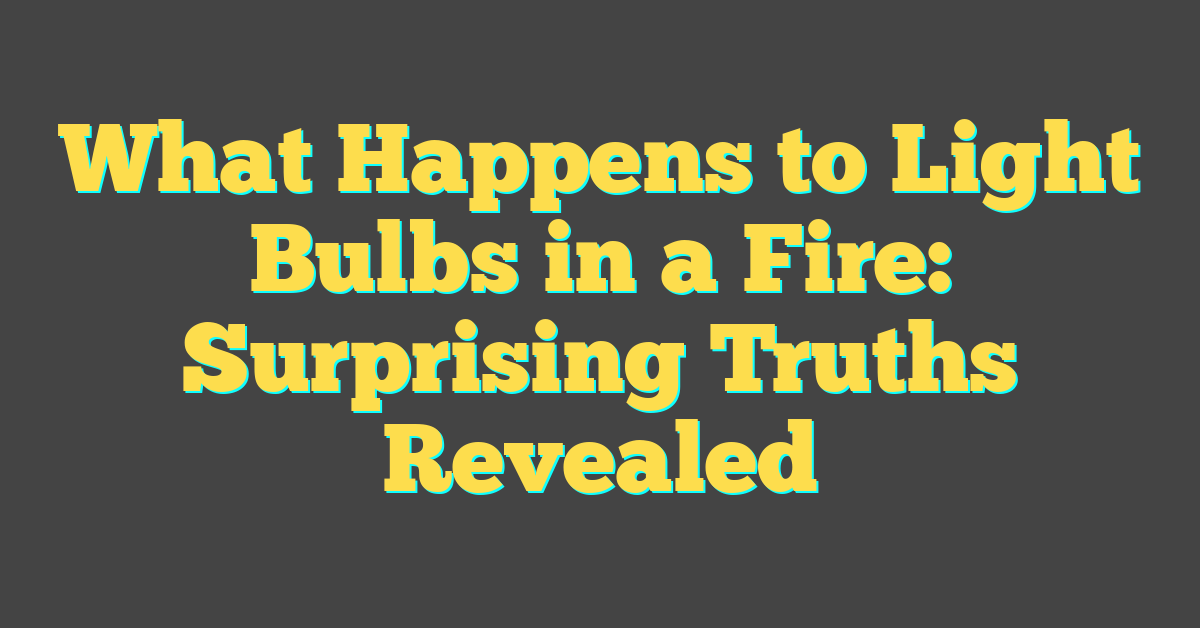Ever wondered what happens to those everyday light bulbs when a fire blazes through a home? It’s a curious thought, isn’t it? You might not give much thought to these fragile glass orbs on your ceiling, but in the heat of a fire, they tell a fascinating story.

As temperatures soar and smoke billows, your light bulbs are about to go through a transformation. They’re designed to light up your life, but what do they do when faced with extreme heat? Let’s shed some light on the science behind bulbs in a blaze.
The Structure of a Light Bulb
Delving into the anatomy of a light bulb will give you greater insight into its behavior during a fire. Your curiosity stems from not just a need to know but also from a love for home DIY projects and all things lighting.
Modern light bulbs are marvels of engineering and design, often going unnoticed until they either flicker out or face a perilous situation like a house fire. At the heart of a typical incandescent light bulb is the filament, a thin wire that emits light when electric current passes through it. This filament is encased in a glass bulb, which is filled with an inert gas like argon to prevent the filament from rapidly oxidizing and breaking.
LED bulbs have a different internal structure but are equally intriguing. They contain a small chip encapsulated in an epoxy resin, which protects the sensitive light-emitting diodes. LED bulbs are known for their durability and energy efficiency, making them a popular choice for home lighting projects.
Here are some key components of a light bulb that play a role in the DIY experience and also during exposure to extreme heat:
- Base: The metal part that connects the bulb to the power supply.
- Glass Bulb: Protects the inner components and allows light to shine out.
- Filament or Diodes: Responsible for light production.
- Inert Gas: Fills the void inside the bulb to improve efficiency and protect the filament.
One might consider the light bulb a simple, everyday object, but it’s these details that make each lighting project unique. From the right type of bulb for your cozy reading nook to the best LED strips to brighten up your kitchen, understanding light bulb anatomy adds another layer to your DIY mastery. It is this very anatomy that undergoes dramatic changes under the extraordinary heat conditions of a fire, which ultimately alters the functionality and structure of these seemingly delicate objects.
How Heat Affects Light Bulbs

When you’re knee-deep in your latest DIY endeavor or meticulously selecting the perfect ambiance for your space, you likely don’t think about how your trusty light bulbs would fare in extreme conditions. But heat plays a pivotal role in the lifespan and functionality of light bulbs.
Incandescent bulbs, by design, already withstand a significant amount of heat. The filament inside reaches temperatures up to 4,500 degrees Fahrenheit when lit. However, during a fire, temperatures can climb much higher, causing the filament to burn out far more quickly or the glass to shatter. These bulbs might not burst immediately due to the vacuum or inert gases inside, but the abrupt temperature change can compromise the bulb’s integrity.
In the case of LED bulbs, they’re more robust in regular use since they operate at cooler temperatures—usually around 80-100 degrees Fahrenheit. That said, they’re not invincible against the fury of a fire. The electronic components and materials inside an LED bulb can degrade or melt at high temperatures, resulting in failure before the outer shell even shows signs of damage.
Let’s talk about the gaseous environment within the bulbs, too. The inert gas inside incandescent bulbs prevents the filament from oxidizing and breaking down. But when a fire hits, these gases expand, potentially leading to a rupture. Meanwhile, the lack of oxygen inside the bulb can delay combustion, but once the glass breaks, oxygen rushes in, and the bulb may erupt.
The base of the bulb, commonly made of metal or plastic, is also susceptible. Metals can warp or melt, whereas plastics will likely melt or burn, which could cause the bulb to detach from the fixture.
Remember:
- High heat can dramatically alter the physical structure of a bulb.
- Different bulb types have varied thresholds and failure modes.
- Components within the bulb react distinctly to increased temperatures.
Understanding how these components interact with extreme heat helps you appreciate the engineering behind your everyday lighting and underscores the importance of the right materials for each situation. Whether you’re planning for safety or efficiency, knowing how your bulbs will respond to heat is as crucial as choosing the right type of light for your home projects.
The Breaking Point: Glass Shattering
« Why Did My Light Bulb Stop Working? Uncover the Moisture Menace
How Do I Know Light Bulb Size? Find Your Perfect Fit with These Tips »

When you’re deep into home DIY projects or geeking out over lighting solutions, knowing the limits of your materials is crucial. Glass, the transparent armor of your light bulb, might seem fragile, but it has an impressive fortitude under normal conditions. However, when a fire rages, the intense heat can push it past its breaking point.
Typically, glass shatters when exposed to rapid temperature changes, a phenomenon known as thermal shock. In the midst of a fire, the air heats unevenly, creating stress within the glass until it can’t withstand the tension. When this happens, the bulb is likely to crack or even explode, posing a danger to its surroundings.
What’s more, the type of glass matters. Borosilicate glass, known for its resistance to thermal shock, will fare better than soda-lime glass, which is the more common but less resilient variety found in many households. Despite the sturdiness of borosilicate, sustaining through a fire is still a formidable challenge.
As you take stock of your lighting installations, consider the glass’s makeup and reflect on how it might react in extreme heat. Although the reality is that most light bulbs aren’t designed to endure the perils of a blaze, it’s enlightening to understand their boundaries—especially if you’re committed to equipping your home against the odds.
Even with the best preparations, the scenario of a light bulb surviving a fire is slim. The materials designed for longevity under normal use just aren’t equipped to tackle the brute force of flames. Ensuring you have the right kind of light bulb for each setting isn’t just savvy; it’s a testament to your dedication to home care and safety.
The Filament’s Fate

In the heart of a light bulb, the filament stands as the central character in the drama unfolding during a fiery event. Incandescent bulbs, with their straightforward design, rely heavily on this thin wire of tungsten. Though it’s engineered to glow fiercely with electricity coursing through, a fire can overwhelm it in moments.
When you’re examining bulbs, you’ll find the filament’s endurance is a game of temperature and time. Surpassing its operating zone, often around 2,500 to 3,000 degrees Fahrenheit, leads it down a swift path to failure. Whether it’s due to the rapid expansion from the heat or degradation of the material, the filament’s luminance is snuffed out like a candle in the wind.
Picture the filament in a desperate struggle to maintain integrity. At typical room temperatures, it’s a resilient actor. But introduce the unyielding heat of a blaze, and you’ll find that it becomes remarkably fragile. In this extreme context, the filament succumbs, often breaking apart long before the glass housing meets its own demise.
Your experience with DIY projects may have shown you that the filament is not just a piece of metal; it’s the soul of the bulb. It’s fascinating to note that the design of filaments hasn’t radically changed since Edison’s time. The slight twist in the metal, a seemingly simple touch, is actually a clever tactic to increase longevity and reduce the material’s vulnerability.
While delving into the finer aspects of lighting, it becomes evident that choosing the right bulb extends beyond wattage and brand—it’s about considering the environment where the bulb will serve its purpose. Whether it’s for your cozy reading nook or illuminating your late-night garage tinkering sessions, consider the filament’s fate. Remember, it’s this tiny coil of metal that will determine how well your bulb stands up to the heat—or doesn’t.
Conclusion
So there you have it! Next time you’re choosing light bulbs for your space consider the environment they’ll be in. While no bulb is invincible in a fire understanding their limits can help you make informed decisions. Remember it’s not just about brightness and energy efficiency but also about how your bulbs will stand up to the heat—literally. Stay safe and let this knowledge light up your choices.
Frequently Asked Questions
What happens to incandescent bulbs when exposed to high temperatures?
Incandescent bulbs can handle high heat, but during a fire, their filament may burn out quickly or the glass might shatter.
Can LED bulbs fail in a fire?
Yes, LED bulbs can fail in a fire due to the degradation or melting of their electronic components and materials.
What effect does fire have on the gaseous environment within a light bulb?
The gaseous environment inside a bulb can expand in a fire, which may lead to the bulb rupturing.
How does heat during a fire affect the base of a light bulb?
The base of a light bulb, whether made from metal or plastic, can warp, melt, or burn when exposed to intense heat during a fire.
At what point does the glass of a light bulb break in a fire?
The glass in a light bulb can shatter during a fire due to thermal shock, and the bulb’s resilience depends on the type of glass used.
Why is it important to understand the limitations of light bulbs in extreme heat?
It’s important to know these limitations to choose the right type of bulb for different environments and conditions.
What role does the filament play in a light bulb’s failure during a fire?
The filament is crucial and can be overwhelmed by a fire’s heat, leading to bulb failure. The design of filaments has remained relatively unchanged since Edison’s time.




